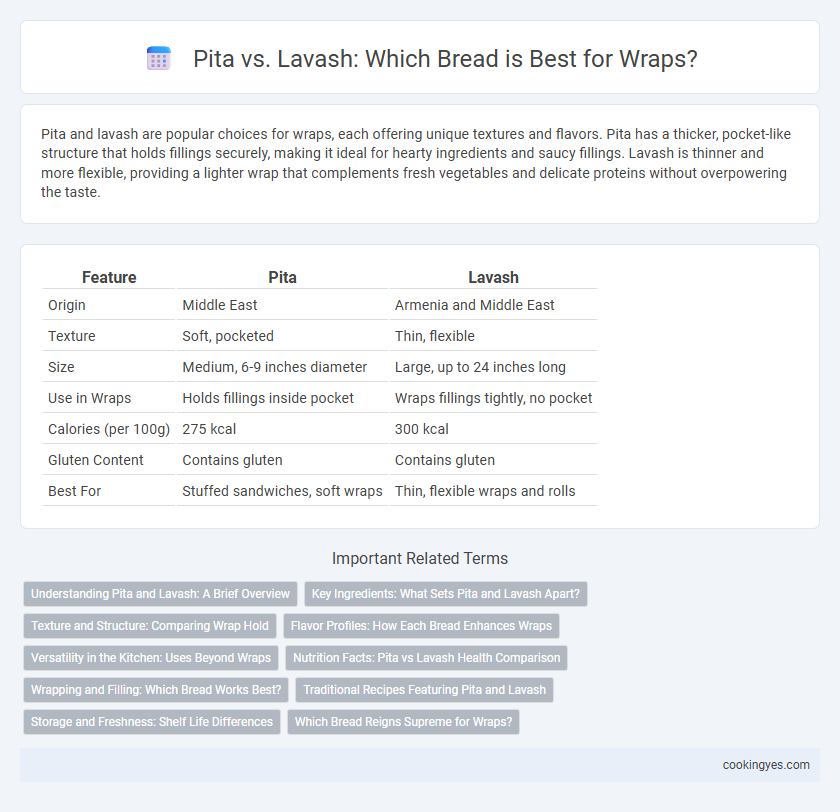Pita and lavash are popular choices for wraps, each offering unique textures and flavors. Pita has a thicker, pocket-like structure that holds fillings securely, making it ideal for hearty ingredients and saucy fillings. Lavash is thinner and more flexible, providing a lighter wrap that complements fresh vegetables and delicate proteins without overpowering the taste.
Table of Comparison
| Feature | Pita | Lavash |
|---|---|---|
| Origin | Middle East | Armenia and Middle East |
| Texture | Soft, pocketed | Thin, flexible |
| Size | Medium, 6-9 inches diameter | Large, up to 24 inches long |
| Use in Wraps | Holds fillings inside pocket | Wraps fillings tightly, no pocket |
| Calories (per 100g) | 275 kcal | 300 kcal |
| Gluten Content | Contains gluten | Contains gluten |
| Best For | Stuffed sandwiches, soft wraps | Thin, flexible wraps and rolls |
Understanding Pita and Lavash: A Brief Overview
Pita and lavash are popular flatbreads commonly used for wraps, each with unique characteristics that influence their culinary applications. Pita is a round, pocketed bread made from wheat flour, known for its soft texture and ability to hold fillings securely within its cavity. Lavash is a thin, soft flatbread typically made from wheat flour and water, prized for its pliability and large surface area, making it ideal for rolling tightly around fillings.
Key Ingredients: What Sets Pita and Lavash Apart?
Pita is made from wheat flour, water, yeast, and salt, creating a soft, pocketed bread ideal for stuffing with fillings, while lavash uses flour, water, and salt but often lacks yeast, resulting in a thin, flexible flatbread perfect for rolling. The yeast in pita dough causes it to puff up during baking, forming a unique pocket, whereas lavash's unleavened or minimally leavened dough remains flat and pliable. These key ingredient differences impact texture and usability, making pita better suited for stuffed wraps and lavash ideal for thin, rolled sandwiches or wraps.
Texture and Structure: Comparing Wrap Hold
Pita offers a thicker, pocketed structure that securely holds fillings without tearing, making it ideal for hearty wraps. Lavash features a thin, flexible texture that allows for tight rolling but can become soggy quickly with moist ingredients. Choosing between pita and lavash depends on the desired wrap consistency and the type of fillings used for optimal hold and texture.
Flavor Profiles: How Each Bread Enhances Wraps
Pita offers a mild, slightly tangy flavor with a soft, pillowy texture that absorbs sauces and fillings, enhancing the overall wrap experience with subtle yeast notes. Lavash brings a delicate, slightly nutty taste and a thin, flexible consistency, providing a crisp contrast that highlights fresh, vibrant ingredients in wraps. Choosing between pita and lavash depends on desired flavor balance: pita complements hearty, savory fillings while lavash elevates lighter, fresh combinations.
Versatility in the Kitchen: Uses Beyond Wraps
Pita offers exceptional versatility in the kitchen, functioning not only as a wrap but also as a base for mini pizzas, dipping bread, and pocket sandwiches. Its pocket structure allows for creative filling combinations, while lavash's flat, pliable texture excels mainly as a wrap or flatbread accompaniment. Chefs often prefer pita for multi-purpose dishes due to its ability to hold ingredients securely and add a satisfying chew to various recipes.
Nutrition Facts: Pita vs Lavash Health Comparison
Pita bread typically contains around 165 calories, 1 gram of fat, and 33 grams of carbohydrates per 60-gram serving, offering a good source of protein and dietary fiber. Lavash, on the other hand, has approximately 140 calories, 0.5 grams of fat, and 28 grams of carbohydrates per 60-gram serving, making it slightly lower in calories and carbs than pita. Both breads provide essential nutrients, but lavash may be a better option for those seeking a lower-calorie, lower-fat wrap choice.
Wrapping and Filling: Which Bread Works Best?
Pita's pocket structure offers a convenient, secure space for fillings, preventing spills and making it ideal for messy ingredients. Lavash, being a thin, flexible flatbread, wraps tightly around fillings, creating a compact, foldable wrap perfect for controlled bites. For wraps requiring hold and containment, pita excels, while lavash suits those prioritizing a thin, pliable bread that closely envelops ingredients.
Traditional Recipes Featuring Pita and Lavash
Traditional recipes featuring pita often highlight its pocket-like structure, ideal for stuffing with falafel, shawarma, or grilled meats, enhancing the wrap's convenience and texture. Lavash, a thin and flexible flatbread, is commonly used in Middle Eastern and Armenian cuisines to create tightly rolled wraps filled with fresh herbs, grilled vegetables, or meats, allowing for a delicate, pliable wrap that holds ingredients securely. Both breads serve as foundational elements in authentic dishes, with pita offering a more robust, hearty bite while lavash provides a lighter, crisp texture, making each suitable for distinct traditional culinary experiences.
Storage and Freshness: Shelf Life Differences
Pita bread typically has a shorter shelf life than lavash, lasting about 3 to 5 days at room temperature compared to lavash's 5 to 7 days due to its higher moisture content. Lavash's thin, flat structure allows it to dry out more slowly and maintain freshness longer when stored properly in airtight packaging. For extended freshness, pita can be frozen for up to 3 months, while lavash also freezes well but may lose pliability faster upon thawing.
Which Bread Reigns Supreme for Wraps?
Pita bread offers a pocket ideal for holding fillings securely, making it perfect for stuffed wraps with ingredients like falafel or gyro meat. Lavash provides a thinner, more flexible texture that wraps tightly without tearing, ideal for fresh and crisp vegetable wraps or delicate meats. When choosing which bread reigns supreme for wraps, pita excels in structural integrity while lavash wins in pliability and softness.
Pita vs Lavash for wraps Infographic

 cookingyes.com
cookingyes.com